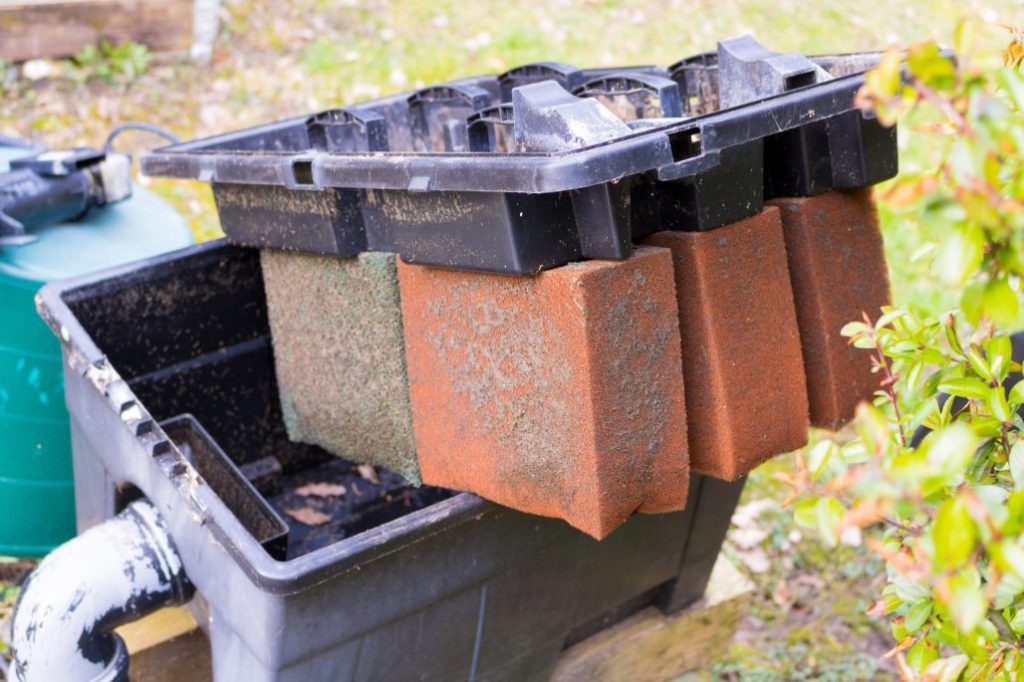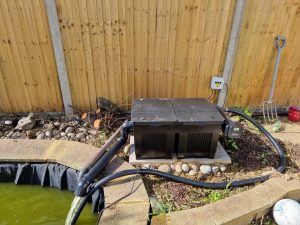
How Pond Filters Work: Essential Guide to Aquatic Ecosystem Maintenance
Pond filters are essential for maintaining clean and healthy water in garden ponds. They remove debris, excess nutrients, and harmful substances that can harm fish and plants. A pond filter works by circulating water through various stages of filtration to trap particles and break down waste.

These systems typically use a combination of mechanical and biological filtration processes. Mechanical filtration catches larger debris like leaves and algae, while biological filtration uses beneficial bacteria to convert harmful ammonia into less toxic compounds.
Many pond owners find that a well-functioning filter system leads to clearer water, healthier fish, and less maintenance overall. Proper filtration also helps balance the pond ecosystem, creating a more stable environment for aquatic life.
Key Takeaways
- Pond filters use mechanical and biological processes to clean water
- Filtration systems remove debris and break down harmful waste
- Proper filtration creates a healthier environment for fish and plants
Understanding Pond Filtration Fundamentals

Pond filters play a crucial role in maintaining clean and healthy water. They use mechanical and biological processes to remove debris and harmful substances, creating a balanced environment for aquatic life.
Role of Pond Filters in Water Quality
Pond filters are the heart of any water feature. They remove physical waste like leaves and algae through mechanical filtration. This process traps particles in filter media, keeping the water clear.
Biological filtration is equally important. It uses beneficial bacteria to break down harmful compounds. These microbes convert ammonia from fish waste into less toxic substances. This process, called the nitrogen cycle, is key to a healthy pond ecosystem.
Regular filter maintenance ensures optimal performance. Clean filters work more efficiently, using less energy and providing better results. A well-maintained filter also helps prevent common pond problems like murky water and algae blooms.
Types of Filtration: Mechanical and Biological
Mechanical filtration is the first line of defence in pond water treatment. It uses filter pads or screens to catch debris. Coarse media traps larger particles, while finer materials remove smaller bits. This step is vital for keeping water clear and reducing the workload on biological filters.
Biological filtration happens in special media that house helpful bacteria. These bacteria convert ammonia to nitrite, then to nitrate. Nitrate is less harmful to fish and can be used by plants as food. Common bio-media include ceramic rings, lava rock, and plastic shapes with lots of surface area.
Some filters combine both types in one unit. This approach is efficient and saves space. Multi-stage filters often have mechanical filtration first, followed by biological treatment. This setup ensures the cleanest, healthiest water for pond inhabitants.
Components of a Pond Filtration System
Pond filtration systems use several key parts to keep water clean and clear. These components work together to remove debris, harmful chemicals, and algae.
Filter Media
Filter media are materials that trap dirt and provide a home for helpful bacteria. Common types include sponges, foam blocks, and ceramic rings. These items catch small bits of waste as water flows through them.
Biological filters use special media like bio-balls. These plastic balls have lots of surface area for good bacteria to grow on. The bacteria break down fish waste and other harmful substances.
Mechanical filters use denser media to catch larger debris. This could be fine mesh or tightly packed foam. They act like sieves, stopping leaves and other big bits from clogging up the system.
Pond Skimmer
A pond skimmer sits at the water’s surface. It pulls in floating debris before it can sink. This keeps the top of the pond clean and clear.
Skimmers often have a basket to catch leaves and twigs. Some also have a foam filter to trap smaller bits. They work non-stop to remove anything that falls into the pond.
Many skimmers house the pond pump. This placement keeps the pump safe and hidden from view. It also makes sure the pump always has enough water to work properly.
UV Light and Clarity
Ultra violet (UV) clarifiers use special lights to kill algae. They sit in-line with the filtration system. As water flows past the light, it zaps tiny algae particles.
This process doesn’t remove the dead algae. But it stops it from growing and making the water green. The dead bits then get caught in the main filter.
UV lights need replacing every year or so. They’re very effective at keeping water clear. But they don’t affect other types of water quality. That’s why they work best as part of a complete filtration system.
Biological Filtration Explained

Biological filtration is a crucial part of pond health. It uses helpful bacteria to clean the water and keep fish safe. This process breaks down harmful waste into less dangerous substances.
The Nitrogen Cycle in Ponds
The nitrogen cycle is key to biological filtration. Fish waste and rotting plants create ammonia, which is toxic to fish. Bacteria turn this ammonia into nitrite, which is still harmful. Then, other bacteria change nitrite into nitrate. Nitrate is safer for fish in small amounts.
This cycle happens all the time in ponds. It’s nature’s way of cleaning water. Pond filters give these helpful bacteria a place to live and work.
Beneficial Bacteria and their Role
Helpful bacteria are the stars of biological filtration. They live on surfaces in the filter. These tiny workers eat fish waste and turn it into less harmful stuff.
Two main types of bacteria do this job:
- Nitrosomonas: Change ammonia to nitrite
- Nitrobacter: Change nitrite to nitrate
These bacteria need oxygen to work well. Good filters make sure they have enough air. As the bacteria grow, they form a slimy layer called biofilm. This biofilm is a sign of a healthy filter.
Choosing the Right Biological Media
Biological media is where helpful bacteria live in the filter. Good media has lots of space for bacteria to grow. It should let water flow through easily.
Common types of media include:
- Plastic balls or shapes
- Foam or sponge
- Ceramic rings
The best media has a rough surface. This gives bacteria more places to stick. It should also be tough and last a long time.
Bigger ponds need more media. The amount depends on how many fish you have and the pond size. It’s better to have too much media than not enough.
Mechanical Filtration and Water Clarity
Mechanical filtration plays a crucial role in maintaining clear pond water. It removes debris and organic waste, keeping the water clean and healthy for aquatic life.
Removal of Organic Waste
Mechanical filters trap solid particles like leaves, fish waste, and algae. These filters use various materials to catch debris as water flows through. Coarse filters catch larger bits, while finer filters remove smaller particles.
Filter mats are a common type of mechanical media. They come in different densities to capture particles of various sizes. As water passes through the layers, it becomes cleaner.
Regular cleaning of mechanical filters is essential. This prevents clogging and ensures the filter works properly. Most pond owners clean their filters every few weeks, depending on the pond’s size and fish population.
Importance of Filter Mats and Mechanical Media
Filter mats and other mechanical media are the workhorses of pond filtration. They create a physical barrier that traps solid waste. This process is the first step in keeping pond water clear.
Different types of mechanical media suit various needs. Foam mats are popular for their efficiency and ease of cleaning. Brushes work well for capturing stringy algae. Bio-balls provide surface area for beneficial bacteria while also trapping debris.
Using a mix of mechanical media often yields the best results. This approach ensures that particles of all sizes are caught. It also helps extend the time between cleanings.
Preventing Green Water
Green water is a common problem in ponds. It’s caused by tiny algae floating in the water. Mechanical filtration helps prevent this issue by removing algae before it can multiply.
UV clarifiers work alongside mechanical filters to combat green water. They damage algae cells, making them clump together. These clumps are then easily caught by the mechanical filter.
Regular water changes also help prevent green water. This dilutes nutrients that feed algae. Combined with good filtration, water changes keep ponds clear and healthy.
Proper plant coverage in the pond is another key factor. Plants compete with algae for nutrients, reducing algae growth. Aim for about 60% of the pond surface to be covered by plants.
Maintenance of Pond Filters
Keeping pond filters in top shape requires regular care and seasonal adjustments. Proper maintenance ensures clean water and healthy fish.
Routine Cleaning and Care
Clean your pond filter every 2-4 weeks. Remove debris from the filter media. Rinse sponges and brushes in pond water, not tap water. This protects helpful bacteria.
Check for clogs in pipes and pumps. Clear any blockages to maintain good flow. Replace worn-out parts promptly.
Test water quality weekly. Look at pH, ammonia, and nitrate levels. Adjust as needed with pond products.
Inspect the filtration system for leaks or damage. Fix issues quickly to prevent bigger problems.
Seasonal Adjustments for Optimal Performance
In spring, clean the filter thoroughly. Remove winter build-up and prepare for increased fish activity.
Summer brings warmer water. Monitor filter performance closely. Add extra aeration if needed.
Autumn calls for more frequent cleaning. Falling leaves can clog filters quickly.
In winter, reduce feeding and filter flow. Remove and store UV clarifiers to prevent damage.
Adjust filter media based on seasonal needs. Use finer media in summer for algae control. Switch to coarser types in autumn to handle leaf debris.
Enhancing Pond Ecosystem Health
A healthy pond ecosystem relies on several key factors working together. These include plants, fish populations, and beneficial microorganisms that maintain water quality.
Role of Aquatic Plants
Aquatic plants play a vital role in pond health. They absorb excess nutrients, provide oxygen, and offer shelter for fish and other organisms. Floating plants like water lilies shade the water, reducing algae growth. Submerged plants like hornwort act as natural filters, trapping sediment and improving clarity.
Marginal plants around the pond’s edge help prevent erosion and filter runoff. A good mix of plant types creates a balanced ecosystem. Aim for about 60% plant coverage in your pond for optimal results.
Balancing Fish Stocking Levels
Proper fish stocking is crucial for pond health. Too many fish can lead to poor water quality and stressed fish. A general rule is 1 inch of fish per square foot of surface area.
Consider the pond’s size, depth, and filtration when stocking. Larger fish produce more waste, so adjust numbers accordingly. Introduce fish gradually to allow the ecosystem to adapt.
Regular monitoring helps maintain the right balance. Remove excess fish if needed to prevent overcrowding. A well-balanced fish population supports a thriving pond ecosystem.
Natural Balance and Beneficial Bacteria
Beneficial bacteria are the unsung heroes of pond health. These microorganisms break down fish waste, uneaten food, and plant debris. They convert harmful ammonia into less toxic nitrites and then nitrates.
To support these bacteria:
- Avoid overfeeding fish
- Remove excess debris
- Maintain good oxygen levels
- Use biological filtration media
A healthy bacterial colony creates a natural balance in the pond. This reduces the need for chemical treatments and supports clearer water. Regular addition of beneficial bacteria can boost this process, especially in new or recently cleaned ponds.
Different Types of Pond Filtration Systems
Pond owners have several options for keeping their water clean and healthy. These systems use different methods to remove debris and harmful substances.
Gravity Filters and Water Gardens
Gravity filters are popular for water gardens. They sit outside the pond, often hidden in landscaping. Water flows through pipes into filter boxes filled with special materials. These materials trap dirt and help good bacteria grow.
Most gravity filters have multiple chambers. The first catches big bits like leaves. Later chambers use finer materials to clean smaller particles. Some have UV lights to kill algae.
Gravity filters work well for ponds without too many fish. They’re easy to maintain and don’t use much power. But they need to be placed higher than the pond surface.
Pressure Filters and Fish Ponds
Pressure filters are great for fish ponds. They can handle more waste and keep up with hungry fish. These filters use a sealed container that forces water through at high pressure.
Inside, there are layers of sponges and other materials. These trap dirt and give space for good bacteria. Many pressure filters have built-in UV lights to fight algae.
You can bury pressure filters in the ground near your pond. This makes them less visible. They work with stronger pumps, so they clean water faster than gravity filters.
External and Submersible Filter Systems
External filters sit next to the pond. They’re easy to access for cleaning. These come in many sizes and types. Some use multiple chambers like gravity filters. Others work more like pressure filters.
Submersible filters go under the water. They’re good for small ponds or as extra filtration. Many combine a pump and filter in one unit. This saves space and looks neat.
Some submersible filters float on the surface. Others sit at the bottom of the pond. They often have fountains or waterfalls attached. This adds oxygen to the water and looks nice.

